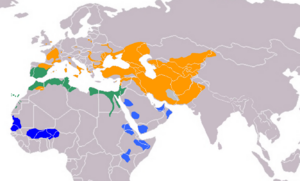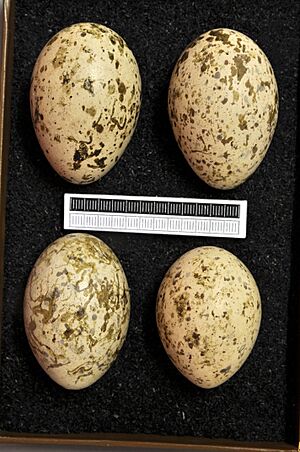Eurasian stone-curlew facts for kids
Quick facts for kids Eurasian stone-curlew |
|
|---|---|
 |
|
| Conservation status | |
| Scientific classification | |
| Genus: |
Burhinus
|
| Species: |
oedicnemus
|
 |
|
| Range of B. oedicnemus Breeding range Year-round range Wintering range | |
| Synonyms | |
|
Charadrius oedicnemus Linnaeus, 1758 |
|
The Eurasian stone-curlew is a cool bird that belongs to the Burhinidae family. People also call it the Eurasian thick-knee because of its unique legs. Its scientific name is Burhinus oedicnemus. This bird is found in many parts of Europe, Africa, and Asia.
Contents
About the Eurasian Stone-Curlew's Name
How the Bird Got Its Scientific Name
The Eurasian stone-curlew was first officially described in 1758. A Swedish scientist named Carl Linnaeus gave it the name Charadrius oedicnemus. He wrote about it in his famous book, Systema Naturae.
Later, in 1811, a German zoologist named Johann Karl Wilhelm Illiger put this bird into a new group, or genus, called Burhinus. The name Burhinus comes from two Greek words. Bous means "ox," and rhis means "nose."
The second part of its scientific name, oedicnemus, also comes from Greek. Oidio means "to swell," and kneme means "shin" or "leg." This name describes the bird's thick-looking leg joints. It's why one of its common names is "thick-knee."
Why It's Called "Stone-Curlew"
The name "stone-curlew" was first written down in 1678. It comes from two main things. First, the bird often makes loud, wailing calls at night. These calls sound a bit like the calls of a different bird called the Eurasian curlew. Second, these birds like to live in dry, stony areas, like heaths.
Different Types of Eurasian Stone-Curlews
Scientists recognize five different types, or subspecies, of the Eurasian stone-curlew:
- B. o. oedicnemus: Found in western and southern Europe, stretching to Ukraine and the Caucasus region.
- B. o. distinctus: Lives in the western Canary Islands.
- B. o. insularum: Found in the eastern Canary Islands.
- B. o. saharae: Lives across North Africa and the Mediterranean islands, reaching Iraq and Iran.
- B. o. harterti: Found from western Kazakhstan to Pakistan and northwest India.
The Indian stone-curlew used to be considered a subspecies of the Eurasian stone-curlew. But now, scientists see it as its own separate species.
What the Eurasian Stone-Curlew Looks Like
The Eurasian stone-curlew is a fairly large wader bird. It's about 38 to 46 centimeters (15 to 18 inches) long. Its wings can spread out from 76 to 88 centimeters (30 to 35 inches). These birds usually weigh between 290 and 535 grams (10 to 19 ounces).
It has a strong beak that is yellow and black. Its eyes are very large and yellow, which can make it look a bit like a reptile. Its feathers have a special pattern that helps it blend in with its surroundings. When it flies, you can see striking black and white markings on its wings.
Where the Eurasian Stone-Curlew Lives
The Eurasian stone-curlew lives across Europe, northern Africa, and southwestern Asia. Many of these birds are migrants. This means they fly to warmer places for winter, like Africa, and then return to Europe and Asia for the summer.
Even though it's called a wader, this bird doesn't usually live near water. Instead, it prefers dry, open areas. It likes places with some bare ground where it can easily find food and build its nest.
Behavior and Life Cycle
Daily Habits and Diet
The Eurasian stone-curlew is mostly active at night. This is especially true when it sings its loud, wailing songs. These songs can sound a bit like the calls of other curlew birds.
These birds eat mostly insects and other small creatures without backbones, called invertebrates. Sometimes, they also eat small reptiles, frogs, and rodents.
Reproduction and Young Birds
Eurasian stone-curlews usually start having chicks when they are about three years old. The female bird lays her eggs in a simple scrape on the open ground. She lays one egg every two days.
Most often, a pair will have two eggs. These eggs are usually about 54 by 38 millimeters (2.1 by 1.5 inches). They are pale cream in color and have different spots or streaks of brown or purple-grey. Both the male and female birds take turns sitting on the eggs to keep them warm. They start incubating after the last egg is laid.
The eggs hatch after about 24 to 26 days. The young chicks are able to leave the nest soon after they hatch. Both parents then take care of them for about 36 to 42 days. Usually, a pair raises only one group of chicks each year. However, if their eggs or young chicks are lost, they might lay another set of eggs.
The oldest Eurasian stone-curlew found in the British Isles lived for 22 years and 4 months! This bird was tagged as a chick in 1990 and was found again in 2012.
Status of the Eurasian Stone-Curlew
The International Union for Conservation of Nature (IUCN) currently lists the Eurasian stone-curlew as a "least-concern species." This means that, overall, there are still many of these birds around the world.
However, some groups of these birds have been decreasing in number. This is often because of changes in farming methods. For example, a study in France found that the number of stone-curlews dropped by 26% over 14 years. This shows that we need to keep an eye on these birds to make sure their populations stay healthy.



